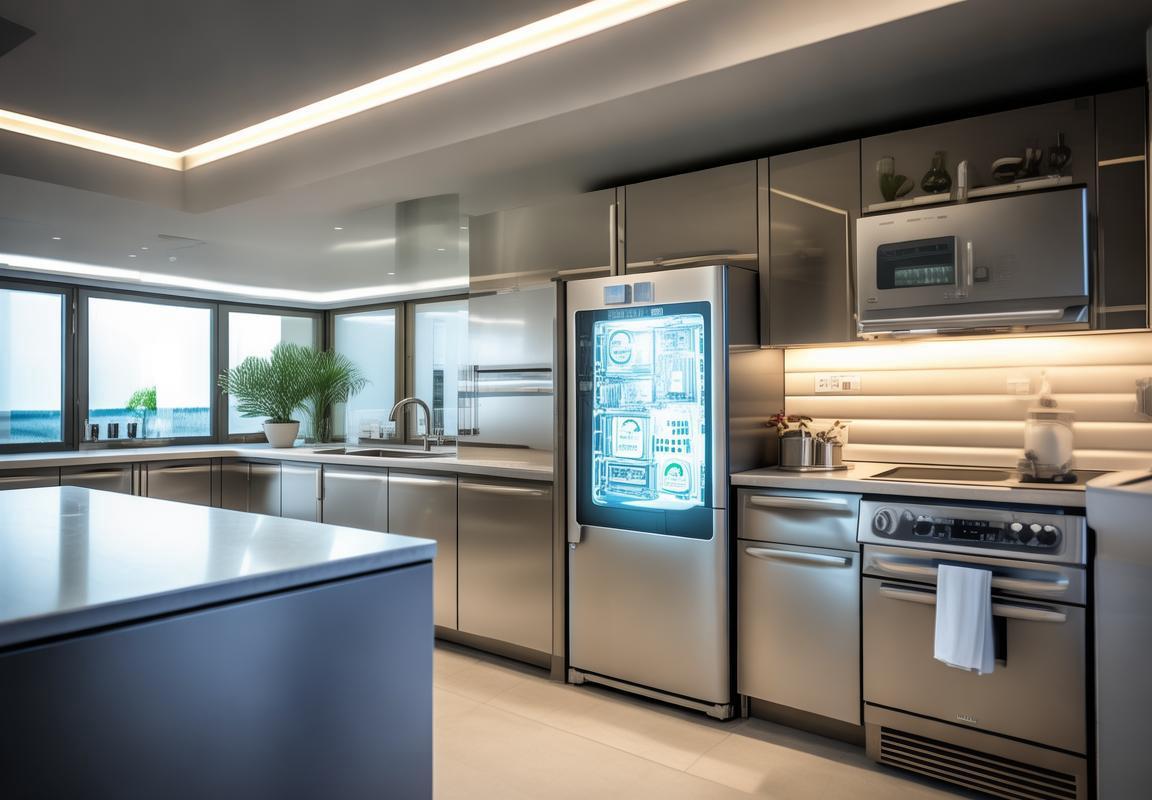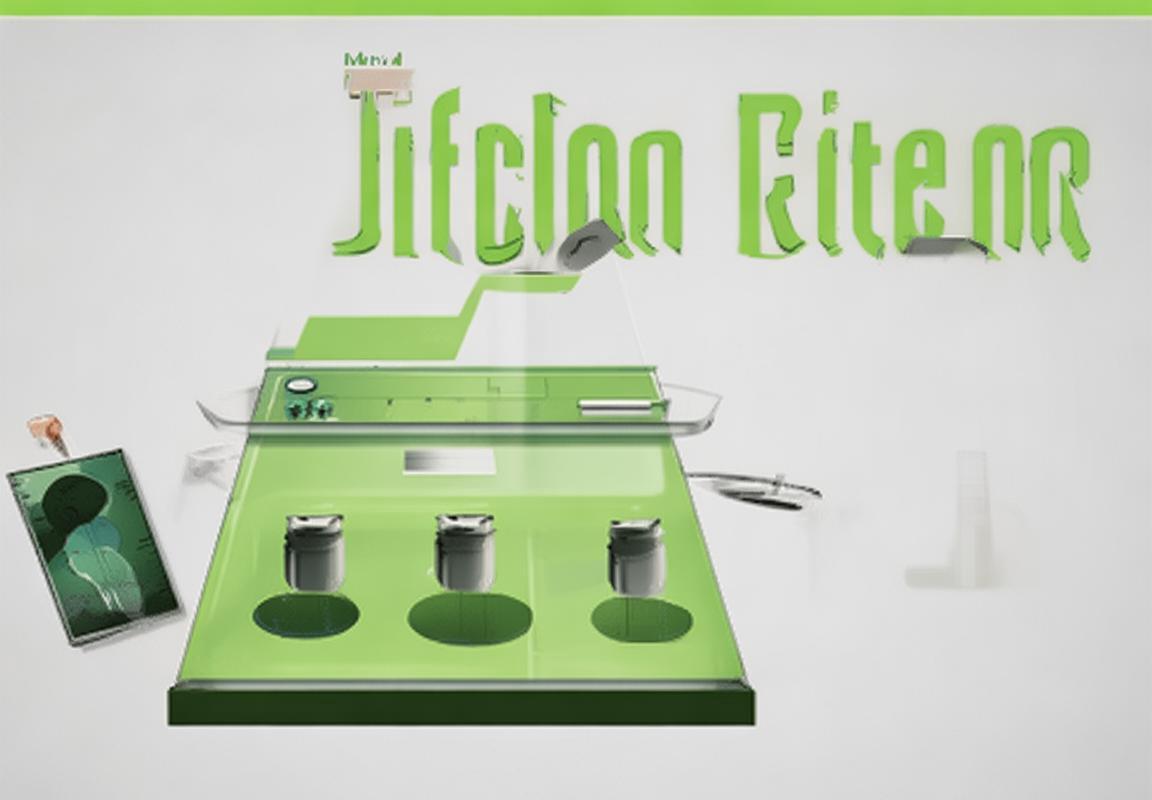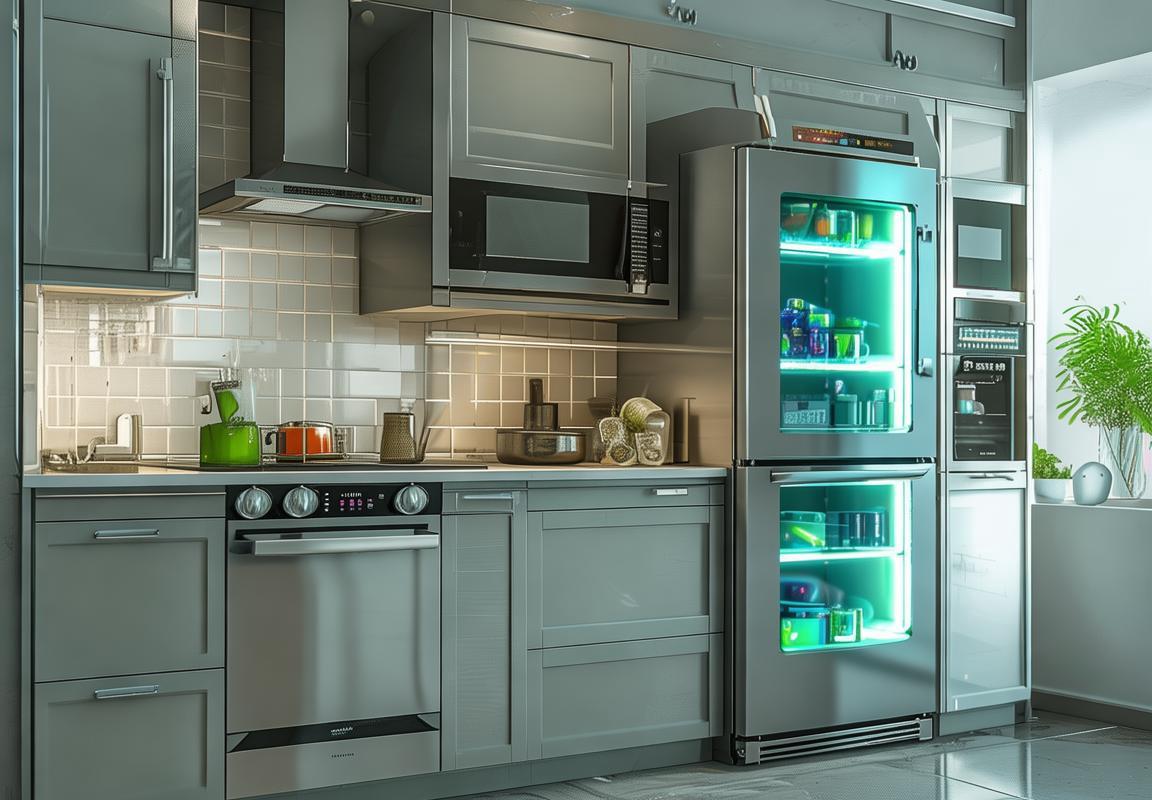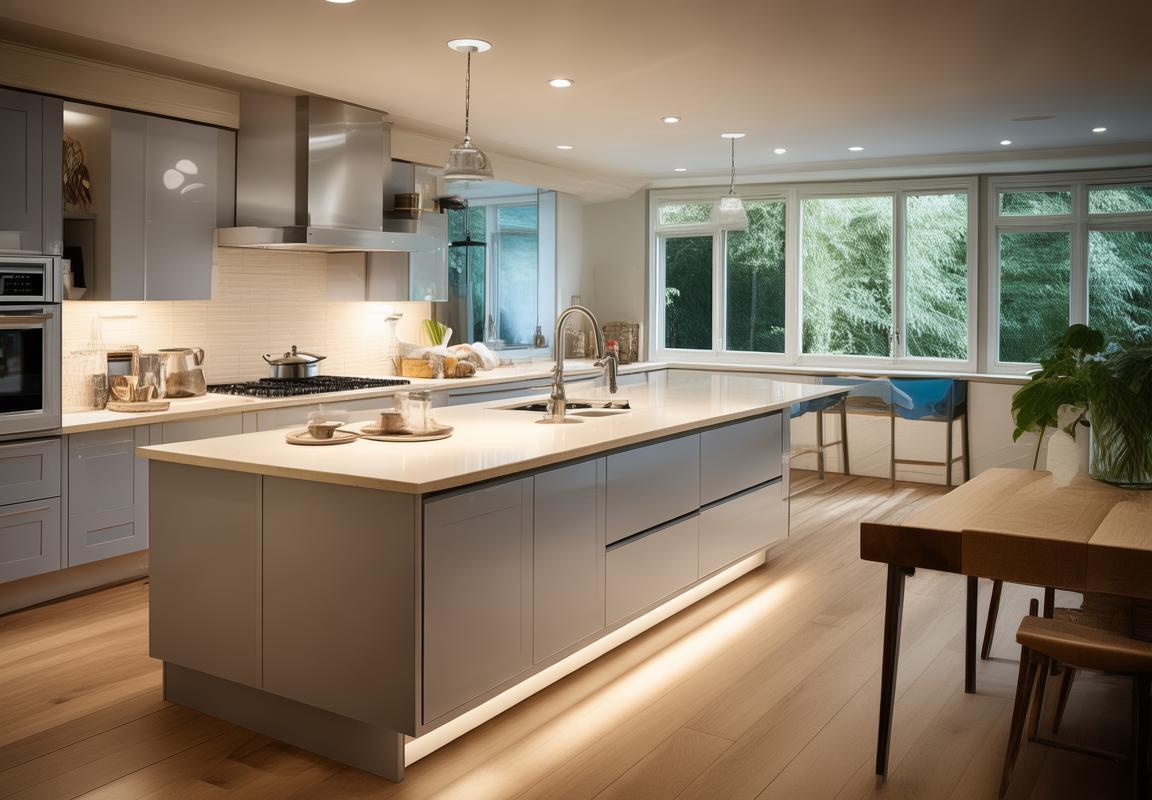In the hustle and bustle of daily life, the kitchen often becomes a hub of energy consumption. But what if you could transform this space into an oasis of efficiency and sustainability? That’s where an energy-efficient kitchen setup comes into play. By embracing smart appliances, thoughtful lighting choices, and strategic insulation and ventilation, you can not only reduce your carbon footprint but also save a considerable amount on your utility bills. Let’s delve into the myriad ways an energy-efficient kitchen can brighten your home and the planet.
Introduction to Energy-Efficient Kitchen Setups
In today’s fast-paced world, where sustainability and cost-effectiveness are at the forefront of our minds, the kitchen—often the heart of the home—presents a unique opportunity for energy efficiency. An energy-efficient kitchen setup not only reduces your carbon footprint but also saves you money on utility bills. Let’s dive into the ins and outs of creating a kitchen that’s both eco-friendly and budget-friendly.
Modern kitchens are a blend of aesthetics and functionality, and with the advent of smart technology, they’ve become even more efficient. From the way we cook to the way we illuminate our spaces, every aspect of a kitchen can be optimized for energy savings. Imagine a kitchen where your appliances work in harmony to minimize energy use, and where every action you take contributes to a greener environment. That’s the potential of an energy-efficient kitchen setup.
When we talk about energy efficiency in the kitchen, we’re not just talking about cutting down on electricity usage. It’s about creating a cohesive system that includes appliances, lighting, insulation, and ventilation, all working together to reduce energy consumption. This holistic approach ensures that your kitchen is not only energy-efficient but also comfortable and convenient.
The journey to an energy-efficient kitchen starts with understanding the key components that make up such a space. From the fridge that keeps your food fresh with minimal energy to the LED lights that brighten your countertops, each element plays a crucial role. Let’s explore these components in more detail.
Firstly, appliances are the backbone of any kitchen. When choosing appliances, look for those with the ENERGY STAR label, which signifies that they meet strict energy efficiency guidelines. A refrigerator, for instance, is a major energy consumer, so opting for a model with a top-mounted freezer can help reduce energy use. Additionally, choosing a refrigerator with an inverter compressor can lead to significant energy savings over time.
Dishwashers are another appliance that can consume a lot of energy, especially if they run frequently. An energy-efficient dishwasher not only uses less water but also heats it more efficiently. Consider a model with eco-friendly wash cycles that can clean your dishes with less energy and water.
Ovens and ranges are essential for cooking, but they can also be big energy hogs. Induction cooktops, for example, heat food faster and more efficiently than traditional electric or gas burners. They generate heat directly on the cookware, which means less energy is lost in the process. When it comes to ovens, preheating to the correct temperature and avoiding opening the door unnecessarily can also help maintain efficiency.
Small appliances, like microwaves and toasters, can also contribute to energy savings. Modern microwaves are designed to be more energy-efficient, and using them instead of a conventional oven for small cooking tasks can save energy. Toasters with automatic shut-off features and energy-saving settings can also reduce energy consumption.
Lighting is another critical area where energy efficiency can be achieved. Traditional incandescent bulbs are inefficient, producing a lot of heat and very little light. Replacing them with LED bulbs can significantly reduce energy use. LEDs are not only more energy-efficient but also have a longer lifespan, which means fewer replacements over time.
In addition to lighting, natural light can play a vital role in an energy-efficient kitchen. By maximizing natural light with large windows and skylights, you can reduce the need for artificial lighting during the day, saving energy and creating a brighter, more inviting space.
Insulation and ventilation are also key factors in an energy-efficient kitchen. Proper insulation keeps the heat in during the winter and out during the summer, reducing the need for heating and cooling. A well-ventilated kitchen ensures that moisture and odors are controlled, which can prevent the need for additional energy-intensive appliances like air conditioners.
Finally, adopting energy-saving habits can make a significant difference. Simple practices like unplugging devices when not in use, using energy-saving settings on appliances, and avoiding unnecessary preheating can all contribute to a more energy-efficient kitchen.
In conclusion, an energy-efficient kitchen setup is not just about the latest gadgets; it’s about creating a balanced system that minimizes energy consumption while maintaining comfort and convenience. By considering the efficiency of appliances, lighting, insulation, and everyday habits, you can transform your kitchen into a sustainable and cost-effective space that benefits both the environment and your wallet.

Why Go Energy-Efficient? The Environmental and Financial Benefits
In today’s fast-paced world, the quest for sustainability and efficiency has become more than just a trend; it’s a necessity. Transitioning to an energy-efficient kitchen setup is not just about reducing your carbon footprint—it’s a smart move that can significantly impact both your wallet and the planet. Let’s delve into the environmental and financial benefits that come with embracing an energy-efficient kitchen.
The environmental impact of an energy-efficient kitchen is profound. By reducing energy consumption, you directly contribute to the mitigation of climate change. Traditional kitchen appliances, such as refrigerators and ovens, consume a substantial amount of electricity, which is often generated from fossil fuels. These fuels release greenhouse gases into the atmosphere, exacerbating global warming. An energy-efficient kitchen, on the other hand, uses appliances that are designed to consume less energy, thereby reducing the demand for fossil fuels and the subsequent emissions.
Moreover, energy-efficient kitchens often incorporate sustainable materials and design principles. For instance, using recycled materials for countertops or choosing appliances with a smaller carbon footprint can help reduce the environmental impact of your kitchen renovation. The reduced need for energy also means a lower demand for power plants, which can lead to a decrease in air and water pollution from these facilities.
From a financial standpoint, the benefits of an energy-efficient kitchen are equally compelling. One of the most immediate advantages is the reduction in energy bills. Modern appliances are engineered to use energy more efficiently, which means they can perform the same tasks as their less efficient counterparts but with a fraction of the energy consumption. Over time, this can result in significant savings, allowing you to allocate those funds to other areas of your life.
Another financial benefit is the potential for government incentives and rebates. Many governments offer tax credits, rebates, or grants to homeowners who install energy-efficient appliances or make other energy-saving improvements to their homes. These incentives can offset the initial cost of upgrading to energy-efficient kitchen setups, making the transition more affordable.
Energy-efficient kitchens also tend to have a longer lifespan. High-quality, energy-efficient appliances are built to last, which means fewer repairs and replacements in the long run. This not only saves money but also reduces the amount of waste generated from discarded appliances.
In addition to direct financial savings, there’s an indirect economic benefit to consider. By reducing our collective energy consumption, we help to stabilize energy prices. This stability can lead to more predictable costs for businesses and consumers alike, fostering economic growth and stability.
Furthermore, an energy-efficient kitchen can enhance the value of your home. As more consumers become environmentally conscious, they are increasingly looking for homes that are energy-efficient. A kitchen that has been upgraded to include energy-saving features can be a significant selling point, potentially increasing the resale value of your property.
The health benefits of an energy-efficient kitchen are also worth mentioning. By reducing indoor air pollution, these kitchens create a healthier living environment. Appliances that are designed to use less energy often operate more quietly and emit fewer harmful emissions, contributing to better air quality within your home.
Lastly, the psychological benefits of an energy-efficient kitchen should not be overlooked. Knowing that you are making a positive impact on the environment can provide a sense of satisfaction and well-being. It’s a reminder that even small changes in our daily lives can lead to significant improvements for the planet and future generations.
In conclusion, the environmental and financial benefits of an energy-efficient kitchen setup are clear. By reducing energy consumption, you’re not only helping to protect the planet but also securing long-term financial savings. The health, economic, and psychological advantages further underscore the importance of making the switch to an energy-efficient kitchen. It’s a win-win situation that benefits everyone from the moment you start enjoying your new, eco-friendly kitchen.

Smart Appliances: The Heart of an Energy-Efficient Kitchen
In the quest for an energy-efficient kitchen, the inclusion of smart appliances is a game-changer. These modern marvels not only enhance convenience but also significantly reduce energy consumption. Let’s delve into how these appliances are the heart of an energy-efficient kitchen.
Smart refrigerators are designed with cutting-edge technology that allows for better temperature control and energy savings. With features like LED lighting that consumes less power and sensors that optimize cooling, these refrigerators ensure that your food stays fresh while using less energy. The ability to remotely adjust settings and monitor food spoilage through smartphone apps adds a layer of efficiency that traditional fridges can’t match.
Dishwashers have come a long way from the energy-guzzling models of yesteryear. Modern dishwashers are equipped with eco-friendly cycles that use less water and energy. Some models even have soil sensors that adjust the cycle time and water usage based on the load’s cleanliness, ensuring that only the necessary amount of water and energy is used. The addition of energy-saving modes and the ability to connect to your home’s smart system for scheduling and monitoring further contributes to the overall efficiency of the kitchen.
Ovens and ranges have also seen significant advancements in energy efficiency. Convection ovens, for instance, circulate hot air around the food, reducing cooking times and temperatures needed to achieve the same results as conventional ovens. Induction cooktops, on the other hand, use electromagnetic fields to heat pots and pans directly, which is more energy-efficient than electric or gas burners. These smart appliances not only save energy but also provide faster cooking times and better temperature control.
Microwaves have become a staple in most kitchens, and their energy efficiency is something to consider. Newer models are designed to use less power while still providing the same cooking capabilities. Features like automatic shut-off and power-saving modes help conserve energy. Additionally, some microwaves now come with programmable settings that allow you to pre-set cooking times and temperatures, ensuring that the appliance is only using energy when necessary.
Small appliances, such as toasters, blenders, and coffee makers, also play a role in an energy-efficient kitchen. Modern toasters have automatic shut-off features to save energy once the toasting is complete. Blenders and coffee makers with energy-saving modes and programmable settings help reduce unnecessary energy consumption. These small changes can add up to significant savings over time.
Energy-efficient appliances are not just about saving money on your utility bills; they also have a profound impact on the environment. By reducing energy consumption, these appliances help lower greenhouse gas emissions and contribute to a healthier planet. The production of these appliances is also more sustainable, often using fewer resources and producing less waste.
Moreover, smart appliances offer the added benefit of connectivity. With the ability to integrate with your home automation system, you can control and monitor your kitchen appliances remotely. This means you can adjust settings, turn them on or off, and even optimize their use based on your schedule, all from your smartphone or tablet. This level of control not only saves energy but also adds a layer of convenience to your daily life.
In conclusion, the inclusion of smart appliances in an energy-efficient kitchen is a multifaceted approach to reducing energy consumption and environmental impact. From the fridge to the microwave, each appliance is designed to operate at peak efficiency, saving you money and helping to preserve our planet for future generations. Embracing these technologies is not just a wise investment for your home; it’s a step towards a more sustainable future.

Lighting Choices for Maximum Efficiency
In today’s fast-paced world, where every penny counts and the environment is more crucial than ever, the right lighting choices in your kitchen can make a significant difference. From reducing energy consumption to enhancing the overall ambiance, here’s a closer look at how to light your kitchen efficiently.
-
Embrace LED LightingLED bulbs have revolutionized the lighting industry with their efficiency and longevity. These compact and energy-saving bulbs consume up to 75% less electricity than traditional incandescent bulbs. Not only do they save money on your utility bills, but they also last much longer, often lasting 20 to 25 times longer than the old-fashioned bulbs. This means fewer replacements and a lower carbon footprint.
-
Natural Light is KeyOne of the most energy-efficient ways to light your kitchen is by maximizing natural light. Consider large windows, skylights, or glass doors that let in ample sunlight. Natural light not only illuminates your space without the need for artificial bulbs but also has been shown to boost mood and productivity. By designing your kitchen to take advantage of daylight, you can reduce the reliance on artificial lighting, thereby cutting down on energy usage.
-
Task-Specific LightingIn a kitchen, different areas serve different purposes, and it’s important to have lighting that caters to these tasks. Under-cabinet lighting, for instance, is perfect for providing focused illumination on countertops, which is where most of the food preparation happens. LED strips or puck lights are energy-efficient options that can be installed beneath cabinets without the need for bulky fixtures.
-
Motion Sensors for Added ConvenienceMotion sensor lights are another great way to conserve energy in your kitchen. These lights automatically turn on when movement is detected and turn off after a set period of inactivity. This feature is particularly useful in high-traffic areas or in corners where you might not always remember to turn off the lights. Motion sensors not only save energy but also provide added safety by illuminating the way when you enter the kitchen at night.
-
Recessed Lighting for a Clean LookRecessed lighting, or can lighting, is a popular choice for kitchens because it offers a sleek and modern look without taking up space. These lights are installed in the ceiling, and the light fixture is concealed, leaving only the light itself to shine through. While recessed lighting can be energy-efficient, it’s important to ensure that the bulbs used are energy-saving LEDs or CFLs (compact fluorescent lamps) to maximize efficiency.
-
Dimmable Bulbs for FlexibilityDimmable bulbs are a fantastic addition to any energy-efficient kitchen setup. They allow you to adjust the light level to suit your mood or the task at hand. Whether you want a bright, well-lit space for cooking or a soft, warm atmosphere for dining, dimmable bulbs provide the flexibility to create the perfect environment. Plus, using dimmer settings can further reduce energy consumption by using less light when it’s not needed.
-
Avoid Energy-Hogging FixturesThere are some kitchen lighting fixtures that are notorious for their energy consumption. Avoid large, ornate chandeliers unless they are equipped with energy-efficient bulbs. Instead, opt for fixtures that are designed to use less energy, such as pendants with integrated LEDs or flush-mount fixtures that can be replaced with energy-saving bulbs.
-
Energy-Efficient Light FixturesWhen it comes to choosing light fixtures, always look for those that are labeled as energy-efficient. These fixtures are designed to work with energy-saving bulbs and can often be more efficient than traditional fixtures, even when the same type of bulb is used.
By making thoughtful lighting choices in your kitchen, you can create a space that is not only beautiful but also kind to the environment and your wallet. The right combination of natural light, task-specific fixtures, and energy-efficient bulbs can transform your kitchen into a beacon of efficiency and style.

Insulation and Ventilation: Keeping Energy In and Out
In the quest for an energy-efficient kitchen, the right insulation and ventilation can make a significant difference. Here’s how these two elements play a crucial role in maintaining a comfortable, eco-friendly space.
Windows and Doors: The Gatekeepers of EnergyWindows and doors are not just portals to the outside world; they are also the gatekeepers of your kitchen’s energy efficiency. Double-glazed windows, with their insulating panes, can significantly reduce heat loss in the winter and keep the cool out during the summer. Similarly, energy-efficient doors with weather stripping can prevent drafts and maintain a stable indoor temperature.
Insulating Materials: The Warmth RetainerInsulation is the key to keeping your kitchen warm in the colder months and cool in the warmer ones. Materials like fiberglass, cellulose, or foam can be installed in walls, floors, and ceilings to create a barrier against temperature fluctuations. This not only saves energy but also reduces the need for excessive heating or cooling, leading to lower utility bills.
Sealing Air Leaks: The Impermeable ShieldNo matter how well-insulated your kitchen is, air leaks can undermine its efficiency. Inspect your kitchen for gaps around windows, doors, and outlets, and seal them with caulk or weather-stripping. This simple step can prevent warm air from escaping in the winter and cool air from escaping in the summer, ensuring that your HVAC system works more efficiently.
Ventilation Systems: Balancing Comfort and EfficiencyWhile insulation keeps the temperature stable, proper ventilation is essential for air quality and comfort. Kitchen ventilation systems, such as range hoods and exhaust fans, help remove moisture, odors, and excess heat from cooking. Energy-efficient models can reduce energy consumption while still providing effective air exchange.
Natural Ventilation: Letting in Fresh AirIn addition to mechanical ventilation, natural ventilation can be a cost-effective way to improve air quality and reduce energy use. By opening windows and using cross-ventilation, you can bring in fresh air and exhaust stale air. This approach is particularly useful during mild weather when the HVAC system doesn’t need to work as hard.
Smart Thermostats: Tailoring Ventilation to NeedsSmart thermostats can help you manage your kitchen’s ventilation system more efficiently. By learning your habits and preferences, these devices can adjust ventilation schedules to match your cooking patterns, saving energy when you’re not cooking and providing fresh air when you need it.
Energy-Efficient Appliances: The Whole PictureIt’s important to remember that insulation and ventilation work best when paired with energy-efficient appliances. A modern stove, oven, or refrigerator can reduce the amount of heat generated in the kitchen, making it easier to maintain a comfortable temperature and lower the workload on your ventilation system.
Regular Maintenance: Keeping Efficiency on TrackOver time, insulation can lose its effectiveness due to wear and tear. Regular maintenance, such as checking for any damage or gaps, is crucial to keeping your kitchen energy-efficient. Similarly, ensuring that your ventilation system is clean and functioning properly will prevent it from working harder than necessary.
By focusing on insulation and ventilation, you can create a kitchen that is not only comfortable but also environmentally friendly and cost-effective. These elements work together to maintain a balanced indoor environment, reducing your carbon footprint and saving you money on energy bills.

Energy-Saving Tips for Everyday Use
In the quest for a more energy-efficient kitchen, adopting smart appliances is a game-changer. These innovative devices are designed not only to make life easier but also to significantly reduce energy consumption. Let’s delve into how these smart appliances can transform your kitchen into an energy-saving haven.
Refrigerators and freezers are the workhorses of the kitchen, and their energy efficiency is crucial. Modern models come equipped with features like LED lighting, which uses a fraction of the energy of traditional bulbs. The insulation in these appliances has been improved to keep cool air in and warm air out, reducing the need for the compressor to work overtime. Some refrigerators even have sensors that detect when the door is left open and prompt the compressor to enter energy-saving mode.
Dishwashers have also evolved to be more efficient. Newer models often come with eco-friendly wash cycles that use less water and energy. They are designed to maximize the use of the water that is used, minimizing waste. Some dishwashers even have soil sensors that adjust the cycle based on the cleanliness of the dishes, saving water and energy on less soiled loads. Additionally, the placement of the dishwasher can affect its efficiency; positioning it closer to the sink and avoiding placing it against an outside wall can prevent heat transfer and further reduce energy use.
Ovens and ranges are often the most energy-intensive appliances in a kitchen. Convection ovens, which circulate hot air around the food, can reduce cooking times and temperatures needed, thus saving energy. Induction cooktops, which use electromagnetic fields to heat pots directly, are also highly efficient as they use less heat to achieve the same cooking temperature. It’s important to use lids on pots and pans to trap heat and to avoid preheating the oven to temperatures higher than necessary.
Microwaves may seem like a small player in the energy consumption game, but they can add up over time. A modern microwave with a turntable that rotates food more evenly and efficiently can save energy. It’s also worth noting that smaller microwaves are more energy-efficient than larger ones, even if they have similar power ratings.
Small appliances, like toasters, blenders, and coffee makers, can also be a source of unnecessary energy waste. Opting for those with auto shut-off features can prevent them from drawing power when not in use. For appliances like blenders and food processors, choosing those with variable speeds allows you to use the minimum amount of power required for the task at hand.
LED lighting has revolutionized the way we illuminate our spaces. These bulbs use 75% less energy than traditional incandescent bulbs and last up to 25 times longer. In a kitchen, LED lighting can be strategically placed to provide ample illumination while being energy-efficient. Under-cabinet lighting, for example, can highlight workspaces without casting harsh shadows.
Natural light is a free and abundant energy source. By maximizing natural light in your kitchen, you can reduce the need for artificial lighting. Large windows, skylights, and reflective surfaces can all help to brighten up your space and reduce your reliance on electricity for lighting.
Insulation is a key factor in maintaining a comfortable temperature in your kitchen and preventing energy loss. Properly insulated walls, floors, and ceilings can keep the heat out during the summer and in during the winter. This not only saves energy but also reduces the workload on your heating and cooling systems.
Ventilation is equally important in a kitchen. A well-ventilated space can prevent moisture buildup, which can lead to mold and mildew growth. Energy-efficient windows and doors with good seals can help maintain the indoor air quality while minimizing energy loss. Additionally, range hoods and exhaust fans can remove heat and cooking odors, but they should be sized correctly and not oversized to avoid unnecessary energy consumption.
Using energy-saving tips in your everyday kitchen habits can make a big difference. Turn off lights when you leave a room, unplug appliances when they’re not in use, and use power strips to control multiple devices at once. Keeping your appliances clean and well-maintained can also improve their efficiency. For instance, a dirty refrigerator has to work harder to maintain its temperature, while a well-lubricated door seal ensures a tight seal and minimizes energy loss.
When cooking, using lids on pots and pans can help retain heat, reducing the amount of energy needed to bring food to the desired temperature. Also, consider using a slow cooker, which uses less energy than an oven and is perfect for longer cooking times. Planning your meals to batch-cook and reheat can also save energy, as you can use one appliance to prepare multiple dishes.
Water conservation is another area where small changes can add up to significant savings. Fixing leaks, using efficient faucets and showerheads, and collecting water for plants or cleaning can all reduce water usage and, by extension, the energy required to heat that water.
Remember, every small step counts. By integrating energy-efficient appliances, lighting, insulation, and ventilation, as well as adopting smart everyday habits, you can create a kitchen that’s not only efficient but also kind to the environment and your wallet.

Conclusion: A Greener Kitchen, A Greener World
As you stand in your kitchen, the heart of your home, it’s easy to overlook the impact it has on the environment and your wallet. However, making your kitchen energy-efficient can not only reduce your carbon footprint but also save you money in the long run. From smart appliances to energy-saving habits, here’s how you can make your kitchen a beacon of sustainability and financial prudence.
In a world where climate change is a pressing concern, the choices we make in our homes can have a significant impact. The kitchen, with its myriad of appliances and energy demands, is no exception. By embracing energy-efficient practices and technologies, you’re not just contributing to a greener world; you’re also securing your family’s comfort and saving on utility bills. Let’s explore the various ways in which you can transform your kitchen into an eco-friendly haven.
Imagine a kitchen where the fridge operates with minimal energy, the oven,。 This is the realm of smart appliances, which are designed to maximize efficiency while offering convenience. Modern fridges, for instance, use advanced insulation and cooling systems to keep your food fresh without guzzling power. Dishwashers with eco-modes and energy-saving cycles ensure that your dishes are cleaned efficiently with minimal energy use. Ovens and ranges that heat up faster and maintain temperatures better also consume less electricity. Even microwaves and small appliances have been upgraded to be more energy-efficient, allowing you to enjoy your favorite snacks and meals with a clear conscience.
Lighting plays a crucial role in the energy efficiency of a kitchen. Traditional incandescent bulbs are a thing of the past; LED lighting is the way forward. These bulbs use up to 75% less energy than incandescents and last up to 25 times longer. Their bright, crisp light is perfect for task-oriented kitchens, and they come in various colors and designs to match any decor. Additionally, consider installing dimmer switches and motion sensors, which can further reduce energy consumption by illuminating only when needed. Don’t underestimate the power of natural light; large windows, skylights, and reflective surfaces can brighten up your space and reduce the need for artificial lighting.
Insulation and ventilation are two key components of an energy-efficient kitchen. Proper insulation keeps the heat in during the winter and out during the summer, reducing the load on your heating and cooling systems. This means your appliances don’t have to work as hard to maintain a comfortable temperature, leading to lower energy consumption. Ventilation, on the other hand, ensures that excess heat and moisture are removed, preventing the buildup of mold and bacteria, and keeping your kitchen air quality high. Consider upgrading to high-efficiency exhaust fans and investing in high-quality window treatments that can block unwanted heat gain.
One of the simplest and most effective ways to save energy in your kitchen is by adopting energy-saving habits. Turn off the tap while brushing your teeth or washing dishes, and only run the dishwasher or washing machine with full loads. Unplug electronics when they’re not in use, and consider using a power strip to control multiple devices at once. When cooking, use lids on pots and pans to trap heat and reduce cooking times. Opt for pots and pans with dark, non-reactive surfaces, as they absorb and retain heat better than lighter-colored, reflective materials.
The benefits of energy-efficient kitchen setups are twofold: environmental and financial. By reducing your carbon footprint, you’re helping to combat climate change and preserving natural resources for future generations. Financially, you’ll see lower utility bills, and over time, these savings can add up to a significant amount. Moreover, many energy-efficient appliances qualify for rebates and tax incentives, making the initial investment more manageable.
In conclusion, transforming your kitchen into an energy-efficient space is not just a trend; it’s a responsible choice for the health of our planet and your wallet. With smart appliances, strategic lighting, effective insulation, and simple energy-saving habits, you can create a greener kitchen that contributes to a greener world. Every small change you make today can lead to a brighter, cleaner future for us all.